Brittle stars are a type of echinoderm that lives in the deepest parts of the ocean. They resemble a more eccentric version of starfish, with their long, slender arms and distinct central disc. These unique creatures come in various shapes, sizes, and colors. They live on the seafloor and eat tiny organisms and debris. Brittle stars, unlike starfish, can move quickly across the seafloor.
But brittle stars’ uniqueness goes beyond their locomotion. These creatures have a remarkable ability to regenerate lost limbs. Some species can even reproduce through fragmentation. Moreover, brittle stars are essential in maintaining our oceans’ health. As filter feeders, they help remove excess nutrients and pollutants from the water, keeping the ocean clean and healthy.
Have you ever seen a brittle star? These creatures look similar to starfish, but don’t be fooled by their appearance. They are not totally similar to starfish. In this blog, we will share all the details and shocking facts about brittle stars. So, the next time you’re exploring the ocean’s depths, watch for these peculiar creatures. Let’s get started!
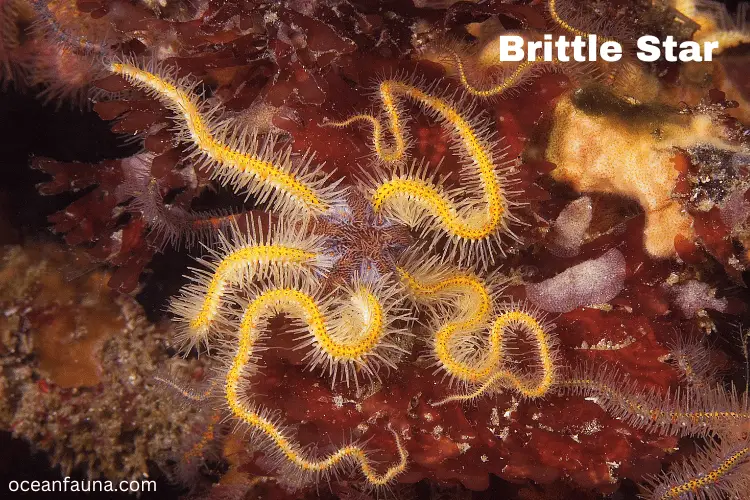
About Brittle Star – A Quick Biology Facts Table
| Parameters | Details |
| Scientific name | Ophiuroidea |
| Kingdom | Animalia |
| Family | Ophiuridae |
| Phylum | Echinodermata |
| Genus | Ophiura |
| Order | Ophiurida |
| Class | Ophiuroidea |
| Species | Ophiura ophiura |
| Habitat and geographical range | All oceans, shallow water, rocky shores and tidal pools |
| Lifespan | up to 5 years |
| Diet | Carnivore, Omnivore |
| Size | 2 ft (0.6 m) |
| Weight | 0.01–0.2 ounces |
| Synonyms | Serpent stars |
Description and Anatomy of Brittle Star
The Class Ophiuroidea encompasses the Brittle or Serpent Stars, distinguished by their agile arms that aid in swift locomotion. Compared to their asteroid relatives, these echinoderms resemble starfish. They acquired their name due to their snakelike undulating motion and tendency to break easily when subjected to attacks. Unlike asteroids, the podia of this class function as sensory organs rather than for active feeding.
Physical Characteristics / Anatomy of Brittle Star
Now gonna share interesting facts about brittle star anatomy. Surprisingly, these marine creatures don’t possess brain, heart and eyes. Besides this, they have a stomach but lack an anus. The waste materials exit via the mouth. They contain a single opening on their ventral side that serves as their mouth and anus. Brittle stars have a mouth with 5 jaws.
The arms of a brittle star are flexible due to the presence of vertebral ossicles made of calcium carbonate. These ossicles function like ball and socket joints, much like our shoulders, allowing the arms to bend and twist. MCT regulates the movement of the ossicles.
This makes the brittle star’s arms much more flexible than those of sea stars, allowing them to move in a fluid, snake-like manner. The flexibility of the arms also allows brittle stars to move swiftly and navigate through tight spaces, such as within corals.
Brittle stars are categorized based on the size of their central disc and arm’s length. The central disc can range from 0.1 to 3 inches in diameter, while the arm length typically ranges from two to three times the diameter. Some brittle stars can have arms that are 20 times or more the size of the disc. Brittle stars vary in weight, with an average range of 0.01 to 0.2 ounces, and come in various colors.
Do You Know? Ophiopsammus maculata is currently the largest known brittle star, with 2-3 inches across the disk and arm lengths between 6-7 inches.
Digestion of Brittle Star
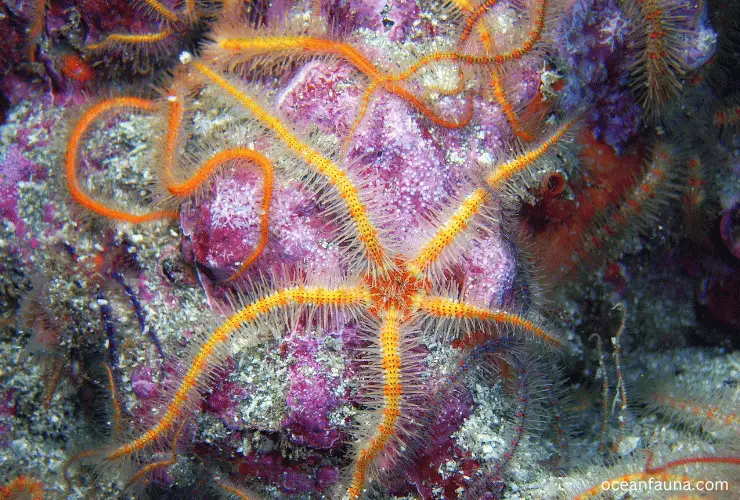
Ophiuroids have jaws surrounding their mouth, functioning as an ingestion and egestion point. The dorsal half of the disk houses the stomach cavity and a short esophagus. Digestion occurs within ten pouches or infolds of the stomach without extending into the arms, unlike in sea stars. The stomach wall is composed of hepatic cells. In general, brittle stars are scavengers or detritivores. The tube feet help move small organic particles into their mouths.
Water-Vascular System & Nervous System of Brittle Star
The tube feet of brittle stars mark the end of the vessels in their water-vascular system. Typically, brittle stars have one madreporite in their water vascular system. However, some Euryalina have one madreporite per arm on their aboral surface, while others lack a madreporite altogether. These marine creatures do not have suckers or ampullae in their tube feet.
A brittle star’s nervous system includes a nerve ring that encircles the central disk and attaches to a radial nerve at the base of each arm. The radial nerves extend to the end of each limb and run through a canal at the base of the vertebral ossicles.
Although most brittle stars lack specialized sense organs like eyes, they possess various sensitive nerve endings in their epidermis that allow them to sense chemicals, touch, and the presence or absence of light. Additionally, tube feet located at the ends of their arms can detect light and odors and can retreat into crevices when stimulated.
Behaviors of Brittle Star
Brittle stars are mainly nocturnal animals and known to be shy and elusive. They are excellent at hiding and quickly retreat into crevices or under rocks when threatened. They move using their arms, which are highly flexible and can move in any direction, making them highly maneuverable. They are also known to regenerate their arms quickly when broken off.
Autotomy, also known as self-amputation, is a defense mechanism utilized by brittle stars when they are under threat from predators. When attacked, the nervous system signals the mutable collagenous tissue near the base of the arm to disintegrate, allowing the brittle star to detach its arm from its body. The wound then heals, and the arm regenerates over a period of weeks to months, depending on the species.
Brittle stars move differently from other echinoderms, such as sea stars and urchins. They do not use their tube feet to move but instead wiggle their arms to propel themselves forward. Despite their radial symmetry, brittle stars can move like bilaterally symmetrical animals. They are the first documented radially symmetrical animals to move in this way.
When moving, a brittle star uses one lead arm to point in the direction it wants to go. The arms on the left and right of the lead arm work together in a rowing motion to move the star forward. This rowing motion resembles the movement of a sea turtle’s flippers. Rather than turning its entire body, the brittle star simply selects a new lead arm to change direction efficiently.
Respiration of Brittle Star
Bursae, sacs lined with cilia, facilitate gas exchange and excretion in Ophiuroids. These sacs open between the arm bases on the underside of the disk. There are typically 10 bursae. Water enters the bursae via ciliary movement or muscular contraction. The hemal system, which is separate from the water vascular system, transports oxygen throughout the body using a series of sinuses and vessels.
Habitat, Range & Distribution of Brittle Star
Brittle stars can be found in all of the world’s oceans, ranging from the deepest sea to intertidal zones, and including both salt and brackish polar areas. These marine creatures can also be available in temperate and tropical waters.
The Indo-Pacific region boasts the highest number of brittle star species, with 825 at all depths. In contrast, the Arctic has the lowest number of species, with only 73.
Some regions are home to an abundance of brittle stars, such as the discovery of “Brittle Star City” off the coast of Antarctica. In this area, tens of millions of these creatures were found packed together in deep water areas.
Feeding Habits/ Diet of Brittle Star
Brittle stars are carnivorous and omnivorous as well. Their diet consists of detritus and small aquatic creatures like plankton, mollusks, algae, and even fish. Some brittle stars will elevate their arms and use them to wrap fish in a spiral and consume them when they approach.
Another feeding mechanism of brittle stars involves lifting their arms to ensnare tiny particles and algae referred to as “marine snow.” They achieve this using the mucous strands on their tube feet, after which the tube feet transport the food to the brittle star’s mouth.
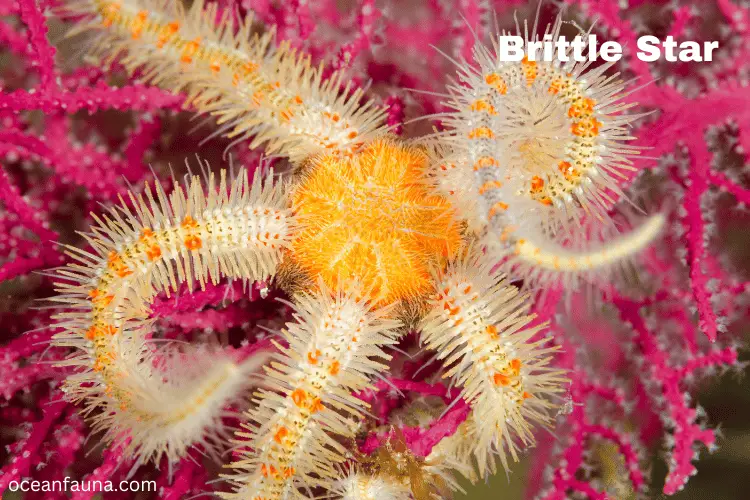
Reproduction System & Life Cycle of Brittle Star
Brittle stars spawn at the end of summer. Most species release their eggs into the plankton. Most ophiuroids have separate sexes, with a small number being hermaphroditic or protandric. The gonads are situated in the central disk and discharge into pouches called genital bursae located between the arms.
External fertilization is typical, with the gametes being released into the surrounding water through the bursal sacs, except in the Ophiocanopidae family. In this family, the gonads are paired and do not open into bursae, instead forming a chain along the basal arm joints.
Several species of brittle stars brood developing larvae in the bursae, giving birth to live young. In some species like Amphipholus squamata, the embryo receives nourishment from the mother through the bursa’s wall, making them truly viviparous.
However, some species have a free-swimming larval stage known as ophiopluteus. Larvae have four pairs of rigid arms and develop directly into adults, lacking the attachment stage seen in most starfish larvae. Few species show this kind of larvae development compared to those that develop directly. They invest in no parental care thereafter.
In addition to sexual reproduction, certain species of brittle stars are also capable of asexual reproduction via fission. This occurs when the central disk of the star is split into two, and each half grows into a new brittle star. These creatures typically achieve sexual maturity around 2 years and reach full adult size by 3 or 4 years. Their lifespan is relatively short, usually around 5 years.
Importance in Ecosystem of Brittle Star
Brittle stars play a crucial role in the ocean’s ecosystem. They are an important food source for many species of fish, sea birds, and marine creatures. In the Arctic region, brittle stars are significant contributors to the local food web.
They act as ecosystem engineers by modifying the seafloor sediment surface and thereby affecting the distribution of other seafloor species. Moreover, they serve as a source of nourishment for various predatory species such as fish, sea stars, and crabs.
Predators of Brittle Star
Brittle stars have several natural predators in their ecosystem. Some of the main predators of brittle stars include
- Crabs
- Fish
- Shrimps
- Seastars
- Octopuses
- Seabirds
- Ballan wrasse
- Common dragonet
- Cuckoo wrasse
Relationship with Humans
Brittle stars have a limited relationship with humans, as they are not typically consumed or harvested for commercial purposes.These marine creatures are a type of invertebrate that is moderately popular among fish enthusiasts.
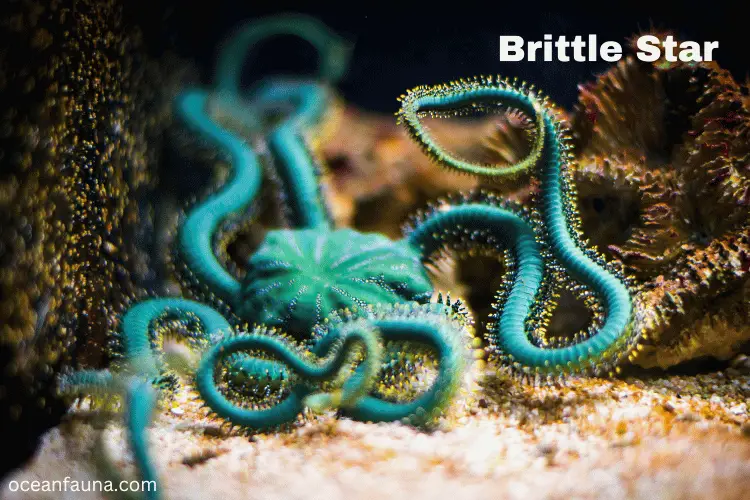
They are able to thrive in marine aquariums and are known to reproduce quickly, making them a common addition to saltwater tanks. In fact, the micro brittle star is often considered a “hitchhiker” as it can easily attach to live rock and propagate in the tank.
Amazing Fun Facts About Brittle Stars
- Some species of brittle stars are even capable of producing their own light through bioluminescence.
- There are more than 3000 species of brittle stars.
- Brittle stars are some of the oldest known species on Earth, with fossil records dating back more than 500 million years.
Similarities Between Brittle Star and Starfish
Following are the similar features between a brittle star and starfish:
- Both belong to the Phylum Echinodermata of Kingdom Animalia.
- They exhibit penta-radial symmetry.
- They are exclusively found in marine environments.
- Both are capable of living in shallow marine environments.
- Also, they are predators.
Difference Between Brittle Star and Starfish
| Feature | Starfish | Brittle star |
| Appearance | Colorful | Colorful |
| Classification | Class Asteroidea | Class Ophiuroidea |
| Movement | Tube feet | Long arms |
| Special features | Ampullae and parapodia | Lacks ampullae and parapodia |
| Digestive system | Complete | Lacks complete system |
Are Brittle Stars Endangered?
No, they are not endangered. No brittle star species are currently listed by the International Union for Conservation of Nature (IUCN).
Are Brittle Stars Safe to Touch?
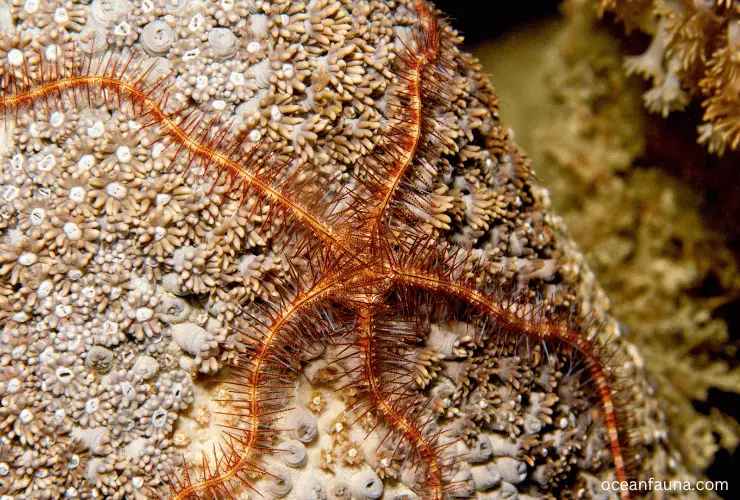
Yes, brittle stars are generally safe to touch. They are not aggressive and dangerous. While they are safe to touch, it is not safe for them to be touched as they are somewhat fragile. Their arms can easily be broken off by accident. In fact, they may intentionally detach one of their arms as a defense mechanism when they sense danger. It is always best to avoid touching these delicate creatures.
FAQs
Is a brittle star a fish?
No, a brittle star is not a fish. It belongs to the phylum Echinodermata. Starfish also belongs to this phylum.
Do brittle stars have hearts?
No, brittle stars do not have hearts.
What’s the lifespan of a brittle star?
The lifespan of a brittle star is up to 5 years.
Can we eat brittle stars as food?
Brittle stars are not commonly consumed as food.
Are brittle stars poisonous?
No, brittle stars are not poisonous. They are not venomous as they lack the ability to produce and deliver venom. Instead, some larger species may have blunt spikes that serve a different purpose.
What is another name for the brittle star?
The other names of brittle stars are ophiuroids and serpent star.
Conclusion
Brittle stars are vital to the health of the ocean environment. These seafloor dwellers play an essential role in the breakdown of organic matter and the cycling of nutrients throughout the ecosystem. They also help to remove harmful pollutants from the water as filter feeders, improving its quality and benefiting other marine life.
Brittle stars have some unique characteristics that make them fascinating creatures to study, in addition to their ecological importance. They can regenerate their limbs if they are damaged or lost, which is a remarkable feat of biological resilience. These marine creatures are also extremely adaptable, with some species surviving in conditions ranging from shallow coastal waters to the underworld depths.

1 thought on “Brittle Star (Ophiothrix Fragilis): Habitat, Diet, Anatomy And Facts”